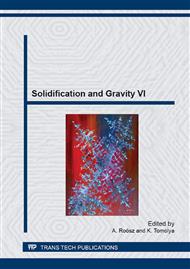p.229
p.235
p.241
p.247
p.253
p.259
p.265
p.271
p.279
Investigating the Foamability Decrease of Water-SiO2 Suspension
Abstract:
Shelf-lives of surfactant containing water SiO2 suspensions were investigated by observing the loss of foamability with time and by making various measurements on the compounds used. Main purposes were to discover the reason of the strong foamability decrease with time and to separate the gravity driven effects. These questions arose in the frame of FOCUS - Foam Casting and Utilisation in Space microgravity experiment preparations (ID: SURE AO-019/PECS 98045, EC contract no: RITA-CT-2006-026069). Foams were prepared using special foaming cartridges, by gas introduction after loading the suspension into the porous structure of the foam generator (FG). Freshly infiltrated FG-s showed superior foamabilities, but this feature was lost after a few days of storage. Several possible chemical or physical reasons were investigated experimentally, including the direction of storage position, composition change, storage temperature, etc. Investigation of gravity-driven sedimentation and creaming tendencies were also examined using dynamic light scattering (DLS) method. These effects found to have significant impact on foamability.
Info:
Periodical:
Pages:
253-258
Citation:
Online since:
May 2014
Authors:
Keywords:
Price:
Сopyright:
© 2014 Trans Tech Publications Ltd. All Rights Reserved
Share:
Citation:


